外研版(2019)选择性必修 第二册Unit 1 Growing up Developing ideas课件(共44张PPT)
文档属性
| 名称 | 外研版(2019)选择性必修 第二册Unit 1 Growing up Developing ideas课件(共44张PPT) |  | |
| 格式 | pptx | ||
| 文件大小 | 58.5MB | ||
| 资源类型 | 教案 | ||
| 版本资源 | 外研版(2019) | ||
| 科目 | 英语 | ||
| 更新时间 | 2024-04-29 11:35:59 | ||
图片预览

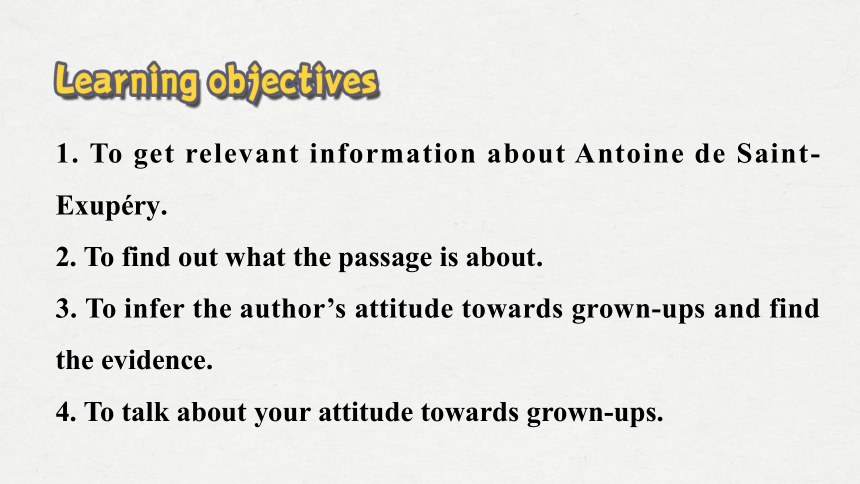
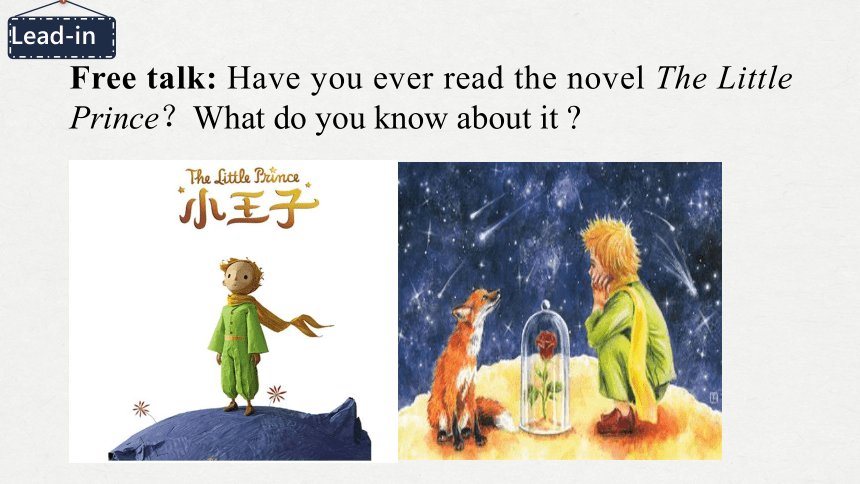
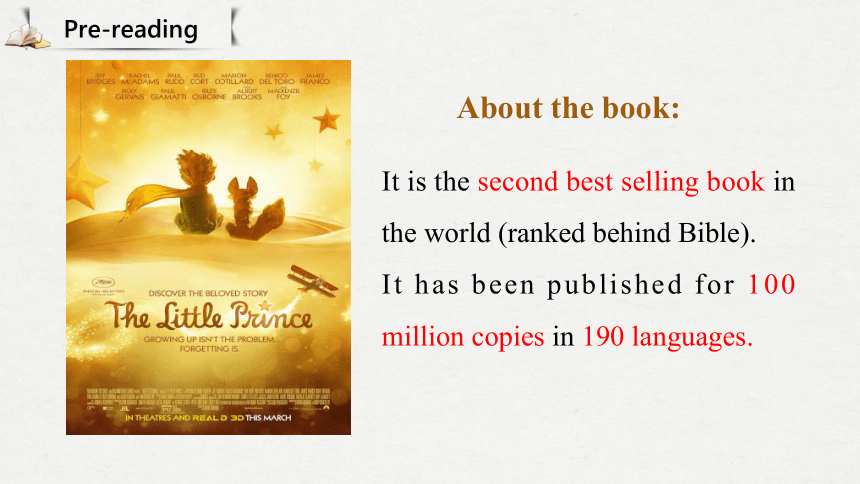

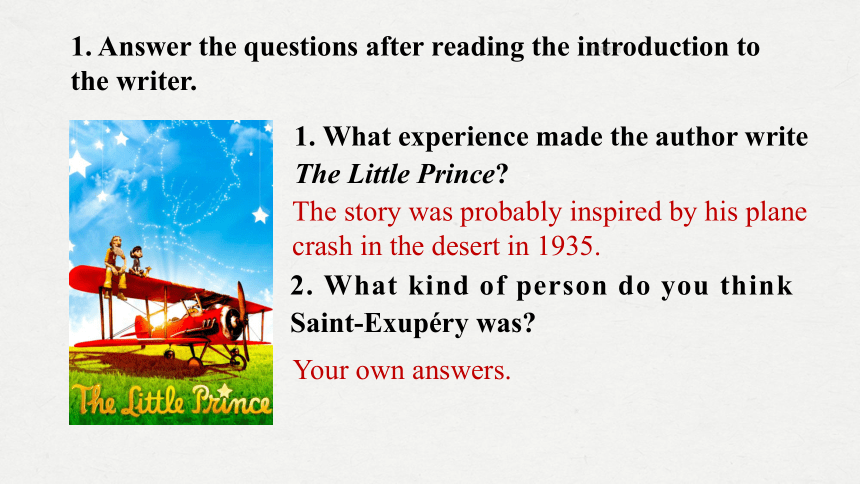
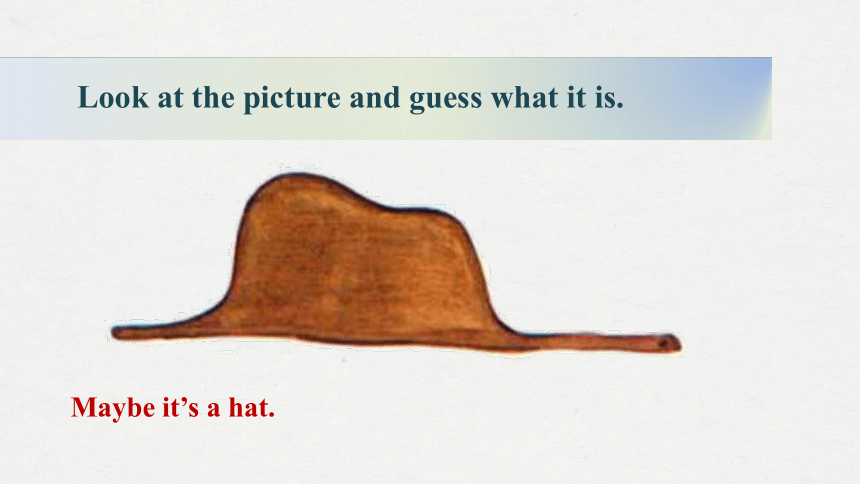
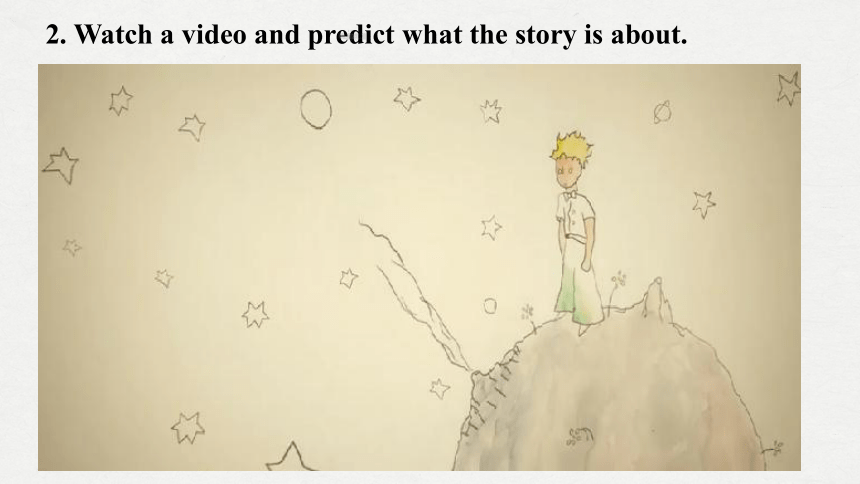
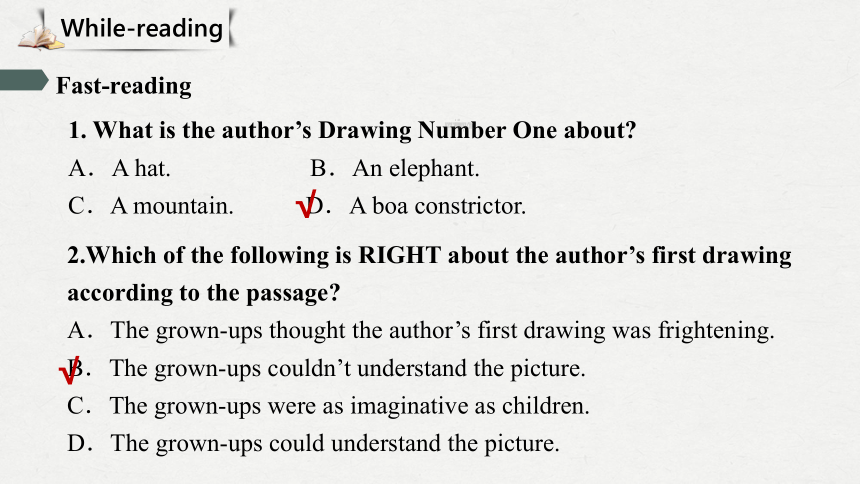
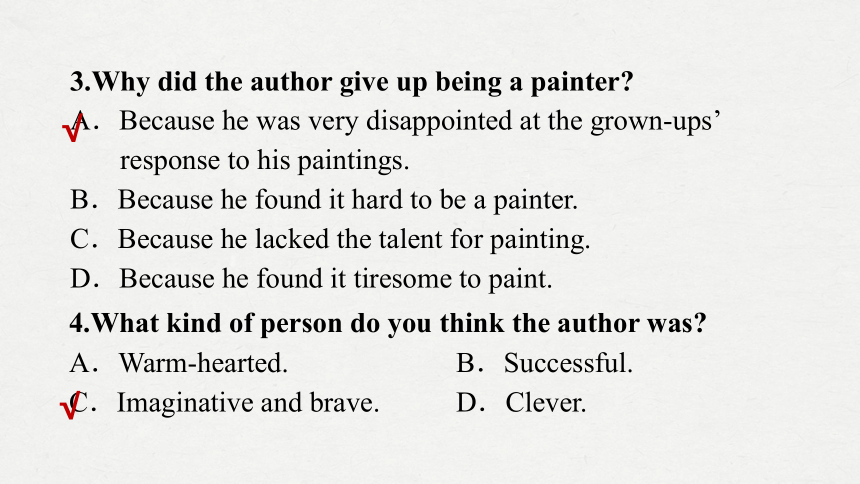
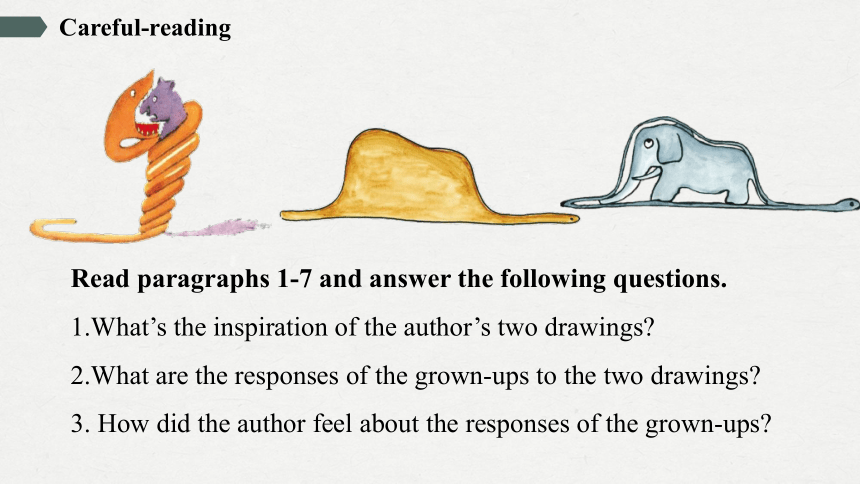
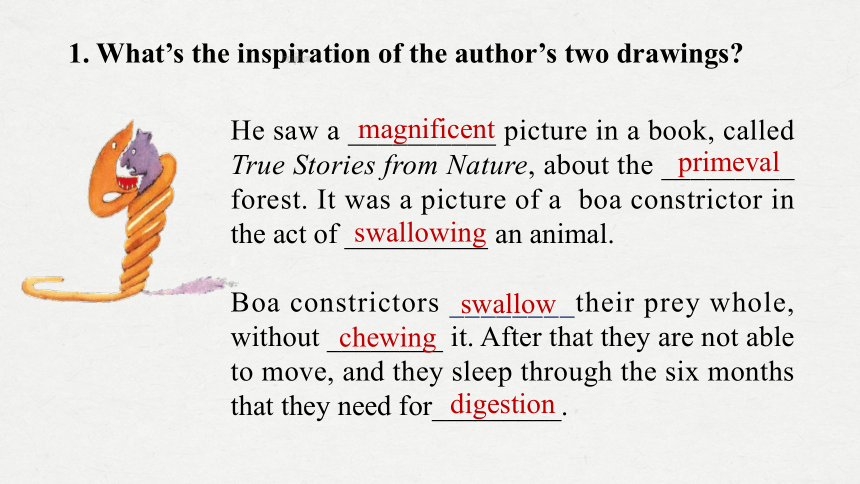
文档简介
(共44张PPT)
Developing ideas—
Reading Comprehension
1. To get relevant information about Antoine de Saint-Exupéry.
2. To find out what the passage is about.
3. To infer the author’s attitude towards grown-ups and find the evidence.
4. To talk about your attitude towards grown-ups.
Free talk: Have you ever read the novel The Little Prince?What do you know about it
Lead-in
It is the second best selling book in the world (ranked behind Bible).
It has been published for 100 million copies in 190 languages.
About the book:
Pre-reading
Antoine de Saint Exupéry (1900-1944) was a French writer
and pilot. As a young boy, he was obsessed with aeroplanes,
riding in one for the first time at the age of 12. He spent much
of his life flying and writing about his adventures. Saint-Exupéry’s most successful work, The Little Prince, is one of the best-selling books ever published. The story was probably inspired by his plane crash in the desert in 1935. Saint-Exupéry nearly died, and wandered around for four days before being rescued. In 1944, Saint-Exupéry left on a wartime mission over occupied France, from which he never returned. Although the remains of his plane were discovered in 2000, Saint Exupéry’s body has never been found, and the cause of his death remains unknown.
Background information
About the author:
1. Answer the questions after reading the introduction to the writer.
1. What experience made the author write The Little Prince
The story was probably inspired by his plane crash in the desert in 1935.
Your own answers.
2. What kind of person do you think Saint-Exupéry was
Look at the picture and guess what it is.
Maybe it’s a hat.
2. Watch a video and predict what the story is about.
While-reading
1. What is the author’s Drawing Number One about
A.A hat. B.An elephant.
C.A mountain. D.A boa constrictor.
2.Which of the following is RIGHT about the author’s first drawing according to the passage
A.The grown-ups thought the author’s first drawing was frightening.
B.The grown-ups couldn’t understand the picture.
C.The grown-ups were as imaginative as children.
D.The grown-ups could understand the picture.
Fast-reading
√
√
3.Why did the author give up being a painter
A.Because he was very disappointed at the grown-ups’
response to his paintings.
B.Because he found it hard to be a painter.
C.Because he lacked the talent for painting.
D.Because he found it tiresome to paint.
4.What kind of person do you think the author was
A.Warm-hearted. B.Successful.
C.Imaginative and brave. D.Clever.
√
√
Read paragraphs 1-7 and answer the following questions.
1.What’s the inspiration of the author’s two drawings
2.What are the responses of the grown-ups to the two drawings
3. How did the author feel about the responses of the grown-ups
Careful-reading
He saw a __________ picture in a book, called True Stories from Nature, about the _________ forest. It was a picture of a boa constrictor in the act of __________ an animal.
Boa constrictors ________their prey whole, without ________ it. After that they are not able to move, and they sleep through the six months that they need for_________.
primeval
swallowing
magnificent
1. What’s the inspiration of the author’s two drawings
swallow
chewing
digestion
The grown-ups answer: Frighten Why should anyone be frightened by a hat
They advised him to _______ his drawings of boa constrictors and ______ himself to geography, history, arithmetic and grammar.
lay aside
devote
2.What are the responses of the grown-ups to the two drawings
He was very ___________ and ________the magnificent career as a painter.
Grown-ups never ___________ anything by themselves, and it is _________ for children to be always and forever explaining things to them.
disheartened
gave up
tiresome
understand
3. How did the author feel about the responses of the grown-ups
Because they have different perspectives on the world. Children understand the world by senses, so they are more creative and imaginative; while the grown-ups are more knowledgeable and experienced, so they are limited and reasonable—literally.
4. Deep thinking:Why did the author and the grown-ups have different ideas Have a discussion with your classmates.
Read paragraphs 8-12 and answer the following questions.
1. What kind of profession did the author choose
2. Why did the author try showing other people his drawing again What were the results
3. Why did the author choose to talk about other topics with the grown-ups
He learned to______________.
It is true that geography has been very ______ to me.
pilot airplanes
useful
1.What kind of profession did the author choose
Whoever it was, he, or she, would always say: “__________.”
He tried the experiment of showing the drawings to_________________________ _________________.
find out if this was a person
That’s a hat
2. Why did the author try showing other people his drawing again What were the results
of true understanding
3.Why did the author choose to talk about other topics
The author wanted to bring himself down to the grown-ups’ level, so the grown-ups would be greatly pleased to have met such a sensible man.
imaginative
creative
pure
innocent
curious
genuine
4.What’s your attitude towards children
…
The structure of the text Paragraphs Main idea
Part 1 Paras. 1-3
Paras. 4-5
Part 2 Paras. 6-7
Para. 8
Part 3 Paras. 9-12
I was deep into a drawing from a book.
The grown-ups’ response to my first drawing.
The grown-ups’ response to my second drawing.
The drawing experience made me choose a new profession.
Later in my life, I held an attitude towards grown-ups.
Careful-reading for structures
1. Complete the blanks.
A.Grown-ups are more practical than children. They want to teach children knowledge that will be useful in the future.
B.Grown-ups are no better than children. They lack imagination and only care about matters of consequence.
C.Grown-ups are more knowledgeable than children. They can understand everything by themselves.
2. Choose the author’s attitude towards grown-ups and find evidence to support your choice.
√
B. Grown-ups are no better than children. They lack imagination and only care about matters of consequence.
Evidence:
1. They always need to have things explained. (Para.6)
2. Grown-ups never understand anything by themselves, and it is tiresome for children to be always and forever explaining things to them. (Para.7)
3. I have had a great many encounters with a great many people who have been concerned with matters of consequence. (Para.9)
4. I would bring myself down to his level. I would talk to him about bridge, and golf, and politics, and neckties. And the grown-up would be greatly pleased to have met such a sensible man. (Para.12)
Read the sentences from the passage and answer the questions.
1.What does the author really mean by these sentences
2.What figure of speech does the author use How does this figure of speech help to express the author’s attitude
Careful-reading for writing techniques
Read the sentences from the passage and answer the questions.
1.What does the author really mean by these sentences
Most of the grown-ups he has met are the same. They focus on practical matters only and seldom pay attention to imagination or creativity.
Read the sentences from the passage and answer the questions.
2.What figure of speech does the author use How does this figure of speech help to express the author’s attitude
Irony. This figure of speech enables the author to indicate his low opinion of adults’ behaviour and values by stressing such things.
Figure of speech ( 修辞)
Irony is a subtle figure of speech that refers to one says that are the opposite of what one really means. It has a humorous, emphatic(强调的) or sarcastic(讽刺的) effect.
More examples:
1. Fine, don’t buy me an airline ticket. I’ll just swim across the ocean.
2. It must be delightful to find oneself in a foreign country without a penny in one’s pocket.
1. After reading the two passages in this unit, what do you think you would acquire and lose as you grow up?(Critical thinking)
Post-reading
Discussion
After reading the two passages in this unit, I have learnt a lot. Being a child or an adult may have its own advantages and disadvantages. As far as I am concerned, being a child is much happier because I don’t take a lot of responsibilities, and I must be taken good care of by my parents, although I have to be supervised by them as well. Being an adult means I will be allowed to do a lot of things that I can’t when I was a child, while I must be mature and strong enough to take responsibilities.
Above all, I can acquire a lot; meanwhile, I may also lose something precious as I grow up. So I hope I will keep a childlike innocence deep in my heart.
2.Can you predict the story of chapter 2 according to the sentence below
Post-reading
Discussion
So I lived my life alone, without anyone that I could really talk to, until I had an accident with my plane in the Desert of Sahara, six years ago...(Creative thinking)
Your own answers.
Let’s enjoy more about The Little Prince.
If you love a flower that lives on a star, it is sweet to look at the sky at night. All the stars are abloom with flowers...
如果你爱上了一朵生长在一颗星星上的花,那么夜间你看着天空就感到甜蜜愉快。所有的星星上都好象开着花。
If you tame me, then we shall need each other. To me, you will be unique in all the world. To you, I shall be unique in all the world.
假如你驯养了我,我们就彼此需要了。对我而言,你就是举世无双的;对你而言,我也是独一无二的……
”It is the time you spent on your rose that makes your rose so important.”
正是你为你的玫瑰花费的时间才使你的玫瑰变得如此重要
It is only with the heart that one can see rightly; what is essential is invisible to the eyes.
一个人只有用心去看,才能看到真实。事情的真相只用眼睛是看不见的。
All the grown-ups used to be children, though few remember it.
Never forget why you started, and your mission can be accomplished.
When I was six years old, I 1._________(success) in making my first picture, after having read the book 2.______(call) True Stories from Nature and pondered 3._______(deep). But to my disappointment, when showed to the grown-ups, the picture was misunderstood. They all thought of the picture of a boa constrictor 4.________(digest) an elephant as a hat. I had to make another drawing, because they need to have things explained. This time, 5.________, they advised me 6._____(be) devoted to geography, history, arithmetic and grammar. I had to give 7.____ my early dream. And I chose another profession. In the course of my life, I have had many 8.__________(encounter) with people who have been concerned with matters of consequence. The result was 9._____ no one was a person of true understanding, and that I was regarded as a 10.________(sense) man.
Fill in the following blanks with suitable words
digesting
however
to be
up
encounters
that
sensible
Summary
succeeded
called
deeply
Once when I was six years old I saw a magnificent picture in a book, called True Stories from Nature, about the primeval forest. It was a picture of a boa contrictor in the act of swallowing an animal. Here is a copy of the drawing.
In the book it said: “Boa constrictors swallow their prey whole, without chewing it. After that they are not able to move, and they sleep through the six months that they need for digestion.”
Analyze the key points of the text
Paras. 1-2
when引导时间状语从句
过去分词作后置定语
正在做某事
here在句首,引起完全倒装
代词
that引导定语从句
I pondered deeply, then, over the adventures of the jungle. And after some work with a colored pencil I succeeded in making my first drawing. My Drawing Number One. It looked like this:
I showed my masterpiece to the grown-ups, and asked them whether the drawing frightened them.
But they answered; “Frighten Why should anyone be frightened by a hat ”
Paras. 3-5
副词修饰谓语
succeed in doing成功做成某事
show sth. to sb.把······给······看
and连接并列谓语
whether引导宾语从句
被······吓到
My drawing was not a picture of a hat. It was a picture of a boa constrictor digesting an elephant. But since the grown-ups were not able to understand it, I made another drawing: I drew the inside of the boa constrictor, so that the grown-ups could see it clearly. They always need to have things explained. My Drawing Number Two looked like this:
Para. 6
现在分词作后置定语
“既然”,引导原因状语从句
be able to...能······
so that引导目的状语从句
have sth. done 让某事被做
The grown-ups’ response, this time, was to advise me to lay aside my drawings of boa constrictors, whether from the inside or the outside, and devote myself instead to geography, history, arithmetic and grammar. That is why, at the age of six, I gave up what might have been a magnificent career as a painter. I had been disheartened by the failure of my Drawing Number One and my Drawing Number Two. Grown-ups never understand anything by themselves, and it is tiresome for children to be always and forever explaining things to them.
Para. 7
不定式作表语
将······放在一边
whether...or...不管······还是······
devote…to…将······投入到······
why引导表语从句
what引导宾语从句
it作形式主语
to do 不定式作真正主语
So then I chose another profession, and learnt to pilot airplanes. I have flown a little over all parts of the world; and it is true that geography has been very useful to me. At a glance I can distinguish China from Arizona. If one gets lost in the night, such knowledge is valuable.
In the course of this life, I have had a great many encounters with a great many people who have been concerned with matters of consequence. I have lived a great deal among grown-ups. I have seen them intimately, close
at hand. And that hasn’t much improved my opinion of them.
Paras. 8-9
it作形式主语,that从句为真正主语
一瞥,看一眼
distinguish...from...区分······
get lost 迷路
“许多,大量”,修饰可数名词
who引导定语从句
副词短语,“大量、许多”,修饰谓语
就在眼前
“关心;和······相关”
Whenever I met one of them who seemed to me at all clear-sighted, I tried the experiment of showing him my Drawing Number One, which I have always kept. I would try to find out, so, if this was a person of true understanding. But, whoever it was, he, or she, would always say:
“That’s a hat.”
Paras. 10-11
whenever引导让步状语从句
who引导定语从句
which引导定语从句
找出,查明
if引导宾语从句
whoever引导让步状语从句
Then I would never talk to that person about boa constrictors, or primeval forests, or stars. I would bring myself down to his level. I would talk to him about bridge, and golf, and politics, and neckties. And the grown-ups would be greatly pleased to have met such a sensible man.
(Excerpt from The Little Prince by Antoine de Saint-Exupéry)
Para. 12
irony 反讽修辞手法
高兴,乐于去做某事
Collect more examples of using irony in English.
Read the passage fluently after class.
Homework
Developing ideas—
Reading Comprehension
1. To get relevant information about Antoine de Saint-Exupéry.
2. To find out what the passage is about.
3. To infer the author’s attitude towards grown-ups and find the evidence.
4. To talk about your attitude towards grown-ups.
Free talk: Have you ever read the novel The Little Prince?What do you know about it
Lead-in
It is the second best selling book in the world (ranked behind Bible).
It has been published for 100 million copies in 190 languages.
About the book:
Pre-reading
Antoine de Saint Exupéry (1900-1944) was a French writer
and pilot. As a young boy, he was obsessed with aeroplanes,
riding in one for the first time at the age of 12. He spent much
of his life flying and writing about his adventures. Saint-Exupéry’s most successful work, The Little Prince, is one of the best-selling books ever published. The story was probably inspired by his plane crash in the desert in 1935. Saint-Exupéry nearly died, and wandered around for four days before being rescued. In 1944, Saint-Exupéry left on a wartime mission over occupied France, from which he never returned. Although the remains of his plane were discovered in 2000, Saint Exupéry’s body has never been found, and the cause of his death remains unknown.
Background information
About the author:
1. Answer the questions after reading the introduction to the writer.
1. What experience made the author write The Little Prince
The story was probably inspired by his plane crash in the desert in 1935.
Your own answers.
2. What kind of person do you think Saint-Exupéry was
Look at the picture and guess what it is.
Maybe it’s a hat.
2. Watch a video and predict what the story is about.
While-reading
1. What is the author’s Drawing Number One about
A.A hat. B.An elephant.
C.A mountain. D.A boa constrictor.
2.Which of the following is RIGHT about the author’s first drawing according to the passage
A.The grown-ups thought the author’s first drawing was frightening.
B.The grown-ups couldn’t understand the picture.
C.The grown-ups were as imaginative as children.
D.The grown-ups could understand the picture.
Fast-reading
√
√
3.Why did the author give up being a painter
A.Because he was very disappointed at the grown-ups’
response to his paintings.
B.Because he found it hard to be a painter.
C.Because he lacked the talent for painting.
D.Because he found it tiresome to paint.
4.What kind of person do you think the author was
A.Warm-hearted. B.Successful.
C.Imaginative and brave. D.Clever.
√
√
Read paragraphs 1-7 and answer the following questions.
1.What’s the inspiration of the author’s two drawings
2.What are the responses of the grown-ups to the two drawings
3. How did the author feel about the responses of the grown-ups
Careful-reading
He saw a __________ picture in a book, called True Stories from Nature, about the _________ forest. It was a picture of a boa constrictor in the act of __________ an animal.
Boa constrictors ________their prey whole, without ________ it. After that they are not able to move, and they sleep through the six months that they need for_________.
primeval
swallowing
magnificent
1. What’s the inspiration of the author’s two drawings
swallow
chewing
digestion
The grown-ups answer: Frighten Why should anyone be frightened by a hat
They advised him to _______ his drawings of boa constrictors and ______ himself to geography, history, arithmetic and grammar.
lay aside
devote
2.What are the responses of the grown-ups to the two drawings
He was very ___________ and ________the magnificent career as a painter.
Grown-ups never ___________ anything by themselves, and it is _________ for children to be always and forever explaining things to them.
disheartened
gave up
tiresome
understand
3. How did the author feel about the responses of the grown-ups
Because they have different perspectives on the world. Children understand the world by senses, so they are more creative and imaginative; while the grown-ups are more knowledgeable and experienced, so they are limited and reasonable—literally.
4. Deep thinking:Why did the author and the grown-ups have different ideas Have a discussion with your classmates.
Read paragraphs 8-12 and answer the following questions.
1. What kind of profession did the author choose
2. Why did the author try showing other people his drawing again What were the results
3. Why did the author choose to talk about other topics with the grown-ups
He learned to______________.
It is true that geography has been very ______ to me.
pilot airplanes
useful
1.What kind of profession did the author choose
Whoever it was, he, or she, would always say: “__________.”
He tried the experiment of showing the drawings to_________________________ _________________.
find out if this was a person
That’s a hat
2. Why did the author try showing other people his drawing again What were the results
of true understanding
3.Why did the author choose to talk about other topics
The author wanted to bring himself down to the grown-ups’ level, so the grown-ups would be greatly pleased to have met such a sensible man.
imaginative
creative
pure
innocent
curious
genuine
4.What’s your attitude towards children
…
The structure of the text Paragraphs Main idea
Part 1 Paras. 1-3
Paras. 4-5
Part 2 Paras. 6-7
Para. 8
Part 3 Paras. 9-12
I was deep into a drawing from a book.
The grown-ups’ response to my first drawing.
The grown-ups’ response to my second drawing.
The drawing experience made me choose a new profession.
Later in my life, I held an attitude towards grown-ups.
Careful-reading for structures
1. Complete the blanks.
A.Grown-ups are more practical than children. They want to teach children knowledge that will be useful in the future.
B.Grown-ups are no better than children. They lack imagination and only care about matters of consequence.
C.Grown-ups are more knowledgeable than children. They can understand everything by themselves.
2. Choose the author’s attitude towards grown-ups and find evidence to support your choice.
√
B. Grown-ups are no better than children. They lack imagination and only care about matters of consequence.
Evidence:
1. They always need to have things explained. (Para.6)
2. Grown-ups never understand anything by themselves, and it is tiresome for children to be always and forever explaining things to them. (Para.7)
3. I have had a great many encounters with a great many people who have been concerned with matters of consequence. (Para.9)
4. I would bring myself down to his level. I would talk to him about bridge, and golf, and politics, and neckties. And the grown-up would be greatly pleased to have met such a sensible man. (Para.12)
Read the sentences from the passage and answer the questions.
1.What does the author really mean by these sentences
2.What figure of speech does the author use How does this figure of speech help to express the author’s attitude
Careful-reading for writing techniques
Read the sentences from the passage and answer the questions.
1.What does the author really mean by these sentences
Most of the grown-ups he has met are the same. They focus on practical matters only and seldom pay attention to imagination or creativity.
Read the sentences from the passage and answer the questions.
2.What figure of speech does the author use How does this figure of speech help to express the author’s attitude
Irony. This figure of speech enables the author to indicate his low opinion of adults’ behaviour and values by stressing such things.
Figure of speech ( 修辞)
Irony is a subtle figure of speech that refers to one says that are the opposite of what one really means. It has a humorous, emphatic(强调的) or sarcastic(讽刺的) effect.
More examples:
1. Fine, don’t buy me an airline ticket. I’ll just swim across the ocean.
2. It must be delightful to find oneself in a foreign country without a penny in one’s pocket.
1. After reading the two passages in this unit, what do you think you would acquire and lose as you grow up?(Critical thinking)
Post-reading
Discussion
After reading the two passages in this unit, I have learnt a lot. Being a child or an adult may have its own advantages and disadvantages. As far as I am concerned, being a child is much happier because I don’t take a lot of responsibilities, and I must be taken good care of by my parents, although I have to be supervised by them as well. Being an adult means I will be allowed to do a lot of things that I can’t when I was a child, while I must be mature and strong enough to take responsibilities.
Above all, I can acquire a lot; meanwhile, I may also lose something precious as I grow up. So I hope I will keep a childlike innocence deep in my heart.
2.Can you predict the story of chapter 2 according to the sentence below
Post-reading
Discussion
So I lived my life alone, without anyone that I could really talk to, until I had an accident with my plane in the Desert of Sahara, six years ago...(Creative thinking)
Your own answers.
Let’s enjoy more about The Little Prince.
If you love a flower that lives on a star, it is sweet to look at the sky at night. All the stars are abloom with flowers...
如果你爱上了一朵生长在一颗星星上的花,那么夜间你看着天空就感到甜蜜愉快。所有的星星上都好象开着花。
If you tame me, then we shall need each other. To me, you will be unique in all the world. To you, I shall be unique in all the world.
假如你驯养了我,我们就彼此需要了。对我而言,你就是举世无双的;对你而言,我也是独一无二的……
”It is the time you spent on your rose that makes your rose so important.”
正是你为你的玫瑰花费的时间才使你的玫瑰变得如此重要
It is only with the heart that one can see rightly; what is essential is invisible to the eyes.
一个人只有用心去看,才能看到真实。事情的真相只用眼睛是看不见的。
All the grown-ups used to be children, though few remember it.
Never forget why you started, and your mission can be accomplished.
When I was six years old, I 1._________(success) in making my first picture, after having read the book 2.______(call) True Stories from Nature and pondered 3._______(deep). But to my disappointment, when showed to the grown-ups, the picture was misunderstood. They all thought of the picture of a boa constrictor 4.________(digest) an elephant as a hat. I had to make another drawing, because they need to have things explained. This time, 5.________, they advised me 6._____(be) devoted to geography, history, arithmetic and grammar. I had to give 7.____ my early dream. And I chose another profession. In the course of my life, I have had many 8.__________(encounter) with people who have been concerned with matters of consequence. The result was 9._____ no one was a person of true understanding, and that I was regarded as a 10.________(sense) man.
Fill in the following blanks with suitable words
digesting
however
to be
up
encounters
that
sensible
Summary
succeeded
called
deeply
Once when I was six years old I saw a magnificent picture in a book, called True Stories from Nature, about the primeval forest. It was a picture of a boa contrictor in the act of swallowing an animal. Here is a copy of the drawing.
In the book it said: “Boa constrictors swallow their prey whole, without chewing it. After that they are not able to move, and they sleep through the six months that they need for digestion.”
Analyze the key points of the text
Paras. 1-2
when引导时间状语从句
过去分词作后置定语
正在做某事
here在句首,引起完全倒装
代词
that引导定语从句
I pondered deeply, then, over the adventures of the jungle. And after some work with a colored pencil I succeeded in making my first drawing. My Drawing Number One. It looked like this:
I showed my masterpiece to the grown-ups, and asked them whether the drawing frightened them.
But they answered; “Frighten Why should anyone be frightened by a hat ”
Paras. 3-5
副词修饰谓语
succeed in doing成功做成某事
show sth. to sb.把······给······看
and连接并列谓语
whether引导宾语从句
被······吓到
My drawing was not a picture of a hat. It was a picture of a boa constrictor digesting an elephant. But since the grown-ups were not able to understand it, I made another drawing: I drew the inside of the boa constrictor, so that the grown-ups could see it clearly. They always need to have things explained. My Drawing Number Two looked like this:
Para. 6
现在分词作后置定语
“既然”,引导原因状语从句
be able to...能······
so that引导目的状语从句
have sth. done 让某事被做
The grown-ups’ response, this time, was to advise me to lay aside my drawings of boa constrictors, whether from the inside or the outside, and devote myself instead to geography, history, arithmetic and grammar. That is why, at the age of six, I gave up what might have been a magnificent career as a painter. I had been disheartened by the failure of my Drawing Number One and my Drawing Number Two. Grown-ups never understand anything by themselves, and it is tiresome for children to be always and forever explaining things to them.
Para. 7
不定式作表语
将······放在一边
whether...or...不管······还是······
devote…to…将······投入到······
why引导表语从句
what引导宾语从句
it作形式主语
to do 不定式作真正主语
So then I chose another profession, and learnt to pilot airplanes. I have flown a little over all parts of the world; and it is true that geography has been very useful to me. At a glance I can distinguish China from Arizona. If one gets lost in the night, such knowledge is valuable.
In the course of this life, I have had a great many encounters with a great many people who have been concerned with matters of consequence. I have lived a great deal among grown-ups. I have seen them intimately, close
at hand. And that hasn’t much improved my opinion of them.
Paras. 8-9
it作形式主语,that从句为真正主语
一瞥,看一眼
distinguish...from...区分······
get lost 迷路
“许多,大量”,修饰可数名词
who引导定语从句
副词短语,“大量、许多”,修饰谓语
就在眼前
“关心;和······相关”
Whenever I met one of them who seemed to me at all clear-sighted, I tried the experiment of showing him my Drawing Number One, which I have always kept. I would try to find out, so, if this was a person of true understanding. But, whoever it was, he, or she, would always say:
“That’s a hat.”
Paras. 10-11
whenever引导让步状语从句
who引导定语从句
which引导定语从句
找出,查明
if引导宾语从句
whoever引导让步状语从句
Then I would never talk to that person about boa constrictors, or primeval forests, or stars. I would bring myself down to his level. I would talk to him about bridge, and golf, and politics, and neckties. And the grown-ups would be greatly pleased to have met such a sensible man.
(Excerpt from The Little Prince by Antoine de Saint-Exupéry)
Para. 12
irony 反讽修辞手法
高兴,乐于去做某事
Collect more examples of using irony in English.
Read the passage fluently after class.
Homework
